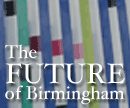Blueprint Birmingham: A look at the City of 2015
By Wade KwonAt a glance: Blueprint Birmingham is a well-considered plan, peppered with great ideas and perhaps a few pie-in-the-sky objectives. Achieving most of the goals in 5 years will make the region far more competitive with an economic impact in the billions of dollars. Two critical components remain unknown for now: the price tag, and the willingness of enough citizens and investors to make it fly.

A new view of Birmingham, from
the recently opened Railroad Park.
Birmingham has never run short on problems, or even solutions to those persistent problems. But what the city and its leaders have often lacked is action.
Today marks the start of a significant 5-year action plan called Blueprint Birmingham, assembled by the Birmingham Business Alliance with consultants from Atlanta’s Market Street Services.
Business leaders will unveil the economic development plan to the public today at 5:30 at the new Railroad Park, but a copy of the plan was furnished to me last week.
The mere existence of a plan — good ideas welded to action steps and deadlines — is a small miracle unto itself. (The Blueprint already distinguishes itself from the feel-good do-nothing approach of Region 2020 or the tax-and-dome policy of the MAPS proposal.) It should be an easy sell to those yearning for progress, any progress.
Let’s dig deeper into the plan itself, after the jump …
Click Full Screen button in lower right to read Blueprint Birmingham.
You can also download, print or share it.
Download the PDF of Blueprint Birmingham.
By the numbers
Blueprint Birmingham features four goals:
- Public and Private Leadership;
- Workforce Development;
- Economic Prosperity;
- Community and Regional Stewardship.
And those goals are broken into 16 objectives, each with its own set of actions. Overseeing all of this will be 12 main committees. The first 3 months will be spent organizing those committees, a mix of Birmingham Business Alliance personnel and leaders from businesses, government and nonprofit agencies.
(The regional plan encompasses seven counties, though I’m willing to bet most people can’t name them all. I surely cannot.)
Also during the first 3 months will be fund-raising, asking members of the alliance’s executive committee and board of directors as well as local companies to make a 5-year pledge. Count on requests for public dollars, too.
Dave Rickey, senior vice president of communications for the alliance, says the group expects to have all financial commitments in place by year’s end, but did not have the total cost available.
And that’s the big number, the cost. Opportunity Austin, a 5-year plan created by the Greater Austin Chamber of Commerce and Market Street, cost $12 million. For their successful efforts, the city reaped huge rewards, including 123,400 new jobs and increased payroll by $5.6 billion.
Phillip McWane of McWane Inc. will lead the fund-raising effort on behalf of Blueprint Birmingham.
Keeping all those numbers front and center will be reports detailing the plan’s progress, at least twice a year and perhaps quarterly, on the Blueprint Birmingham website.
However, the implementation plan — reserved for alliance staff members and Blueprint workers — outlines specific names, timelines and numerous action steps and will not be made public.
The big picture
OK, here’s what you won’t find in the 57-page Blueprint Birmingham:
- cheap children’s laptops;
- a domed stadium;
- a plan for luring the Olympic Games.
What you will find is an emphasis on fixing those four areas: leadership, people, prosperity and place (though the Blueprint uses fancier language). The plan-making process involved community input, analysis of the region’s strengths and weaknesses as well as an examination of the alliance itself.
You will likely find something to love about the plan, and will surely find something you hate about it. Should that be enough to derail the entire effort? Let’s hope not. In a city and a region with fewer options, the plan seems like a sensible place to start.
Buried in the back of the Blueprint are the “Best Practices,” recommendations made by Market Street based on its work with other cities. Each Best Practice details a successful initiative elsewhere that can be duplicated here with less effort.
The Blueprint tackles the region’s most prominent failures head on. And note that admitting failure is not the same as admitting defeat.
Leadership, especially in the political area, remains a troublesome area, as residents have become ever more cynical about the people they put in charge (or likely, let other voters put in charge).
Education, transportation and business retention also mark the dismal recurring failures of the past few decades. And while not every municipality in all seven counties has seen the same problems as Birmingham proper, the effects are felt throughout the region.
Dave Rickey with the alliance notes that regional cooperation will be a tough sell. And the plan carefully steers itself away from any notion of regional government, just cooperation.
But if the plan accomplishes one thing early on, it’s justifying the existence of the Birmingham Business Alliance. Formed in 2009 from bits and pieces of the Birmingham Regional Chamber of Commerce, Region 2020 and the Metropolitan Development Board, the alliance has stood out twice. Once for this plan, the other for the departure of alliance president Dalton Smith, just before the Blueprint was finalized.
The very first objective makes it clear: Have the business community speak with one voice. That should’ve been the alliance all along, but perhaps it will take this plan plus millions of dollars plus tremendous effort to realize that vision.
• • •
How Austin succeeded with its 5-year economic development plan
• • •
Nuts and bolts
• Public and Private Leadership: Who will lead the charge, after many have tried and failed spectacularly? If you believe in the private sector, you will like this part.
This goal pushes business leaders to unite to push for change through partnerships, publicity and legislation. It calls for more communication and collaboration with elected officials and a more transparent government. The goal even reaches out to minorities and young professionals, looking to increase their representation on boards and in public office.
Established business leaders will be asked to step up, too, to run for public office, with backing and guidance from the alliance. In addition, a political action committee will be considered as a means to support business-friendly candidates. The noble side of me recoils at the thought of a PAC, but the practical side thinks it may be the only way to get anything accomplished at the state level.
• Workforce Development: In other words, people. And in other other words, education.
It’s all in there in the objectives: corporate-school partnerships; charter schools; parenting workshops; networking of education leaders; child care; refocusing college programs on needed work skills.
The jobs that aren’t being shipped to foreign countries will require an educated workforce, and Alabama has been way behind in that effort. Fixing education remains a top priority if ever we are to attract new industry to the area.
But as Rickey pointed out, bringing people to the table for Blueprint meetings and changing policy at the boards of education are separate things.
Can business save education? Given our track record to date, we have nothing left to lose.
The plan builds the connection between businesses making education a priority and eventual economic benefit. It will take more than 5 years to see the payoff, but it seems like a good place to start.
• • •
More stories on Blueprint Birmingham.
• • •
• Economic Prosperity: Much of what you’d expect to find in an economic development plan is in this section. Keep established companies from fleeing, help small businesses and entrepreneurs get a foothold, and bring in new industry from elsewhere.
In other words, the job of a chamber of commerce or an economic development office.
Beyond that are two interesting objectives. One is better marketing, to ourselves and to our target markets. The plan calls for emphasis on Birmingham as a hotbed for technology research and innovation (including biology and medicine), and also an emphasis on Birmingham as a tourist destination.
The other interesting objective is betting on the city’s largest employer, the University of Alabama at Birmingham, as an engine for economic development. The plan goes into great detail on how to attract talent, connect businesses with researchers and commercialize discoveries and patents from the university.
In essence, UAB becomes a stronger source of innovation and new business, positioning it to compete with MIT and other research institutions. Pulling off this objective means a win-win for the school and the region.
• Community and Regional Stewardship: Place is the last of the four goals, and it has a grab bag of fixes to improve local quality of life.
For instance, fighting crime. Birmingham continues to rank in the Top 10 in violent crime, which scares off prospective businesses and employees. The Blueprint calls for coordination among public safety organizations, but also for a community court to handle lesser offenses in an alternate manner: more community service and rehab, less jail time.
It has a green section, with steps to improve air and water quality. A really good idea in this section encourages reuse and redevelopment of brownfields (abandoned and toxic industrial sites) and greyfields (unused sites covered in asphalt).
Under “quality of place” are calls to establish a downtown entertainment district, fund the Red Mountain Park and even put in bike paths, which for some reason wasn’t included in infrastructure. That area discusses transit, a quagmire that seems workable on paper but has been nothing but in reality.
Transit and transportation includes the Northern Beltline, Interstate 22, U.S. 280 congestion, broken mass transit, even improving passenger and cargo capacity at the Birmingham-Shuttlesworth International Airport. And for good measure, it also has a broadband wireless study thrown in.
Most telling is the final objective, turning us from naysayers into cheerleaders with marketing. After all, apathy has had a poisonous effect on the city’s prospects through the decades. And selling ourselves to outsiders would be far easier if we were sold on ourselves.
Maybe we will have more to brag about with each new action step accomplished.
• • •
Sign up for the free Wade on Birmingham newsletter.
• • •
Closing thoughts
I asked Dave Rickey of the alliance an unfair question: Is Blueprint Birmingham this city’s last chance?
He said that we’re at a pivotal time. As the economy improves, the city and the region need to position themselves to take advantage of it. But other cities are already moving into place. Rickey added that people are sensing some new optimism, but they’re hungry for things to get better.
Without any action, the City of 2015 will look much like the City of 2010: continuing to slowly decline in population and significance, broken and battered from years of neglect.
Look carefully through Blueprint Birmingham, and you may see a different future. That City of 2015 is the envy of Atlanta, of Charlotte, of Nashville. It still has 90 different municipalities, but they often pull in the same direction. It will have newcomers rushing in to fill jobs and live in a vibrant metropolis. And it will have promise, real promise, fulfilled.
All it will take is money. And a plan. And a lot of very hard work.
Wade Kwon is a Birmingham native and publisher of Wade on Birmingham, which celebrates its fifth anniversary in October.
• • •
Now that you’ve read Blueprint Birmingham, is it what you expected? Is it the way forward? What’s good about it, and what needs improvement? Sound off in the comments.
















Friday, September 24, 2010, 11:25 am
Once again we have so much in common. Except ours is called Big City Plan:
http://bigcityplan.birmingham.gov.uk/
What is good is that the people of Birmingham UK realised this was a lot of council speak and spent hours (days?) translating it into plain English so that more people could comment and contribute their ideas for their city. This was their site.
http://bigcitytalk.org.uk/
And the story behind it:
http://peteashton.com/2009/01/birminghams_big_city_plan_translated_by_volunteers/
Just wanted to share the ideas. 🙂
Friday, September 24, 2010, 1:35 pm
Wade, thanks for posting this yesterday. I wasn’t going to be able to make it to the unveiling, so I was glad to get a look at everything.
All in all I’m ok with the ideas presented and the energy put into improving Birmingham. I definitely disagree on some of the initiatives, but I’m not a baby with the bathwater kind of guy.
My only real disappointment was that I would have loved to see more “new” faces on the steering committee. New faces with new ideas and none of the baggage that comes with the many, many years of decline and failure may have been useful for marketing this as a drastic departure from past initiatives.
There’s a lot of really good and optimistic energy around Birmingham right now and I’m glad to be part of that, if nothing else.
Friday, September 24, 2010, 2:33 pm
Darn good reporting, thanks. Good capturing of quotes from the bba guy too. Man, you cut through the clutter of all this and make it easy to read. Look forward to following your stories on this. Thanks
Friday, September 24, 2010, 4:50 pm
Fiona: That is brilliant. Thank you for sharing.
Donnie: I’ve heard someone else also make the same observation about the steering committee. Check out this story on AL.com. I agree that the committee needed some newer faces, but maybe public input made a difference.
Rube: You’re welcome. Glad you found it helpful.
Friday, September 24, 2010, 7:39 pm
[…] This post was mentioned on Twitter by Wade Kwon, Wade Kwon, Wade Kwon, Wade Kwon, Wade Kwon and others. Wade Kwon said: BLUEPRINT BIRMINGHAM: Your first look at the 5-year economic development plan. http://itswa.de/blueprintbham #bham […]
Saturday, September 25, 2010, 10:15 am
Fascinating post, Wade. Thanks for the easy-to-read summary of the plan – I truly hope that this one is different than all that have come before it.
Although there are a lot of reasons to not feel this way, I have recently felt very optimistic about the changes happening in the downtown area. Parts of it are actually starting to feel like a Metropolitan city now, rather than the shambles of closed-up shops that it consisted completely of when I was a child.
Tuesday, September 28, 2010, 8:02 am
[…] Blueprint Birmingham: A look at the City of 2015 Rachel @ Grasping for Objectivity | Fascinating… Wade | Fiona: That is brilliant. Thank you for… Rube | Darn good reporting, thanks. Good… Donnie | Wade, thanks for posting this… FionaC | Once again we have so much in common…. […]